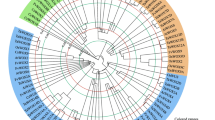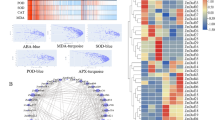Abstract
When the lower leaves of hybrid poplar trees are mechanically wounded, several novel mRNAs accumulate in the unwounded upper leaves (Parsons TJ, Bradshaw HD, Gordon MP: Systemic accumulation of specific mRNAs in response to wounding in poplar trees, Proc Natl Acad Sci USA, in press). A partial cDNA clone corresponding to a transcript from the wound-responsive gene designated win 3 (wound-inducible) has been cloned by differential hybridization to 32P-labelled cDNA from the leaves of wounded trees. Northern blots show a large accumulation of win 3 transcripts in the unwounded leaves of wounded trees. Southern blot analysis of poplar DNA suggests that win 3 is a member of a multigene family. The nucleotide sequences of several win 3 cDNA clones have been determined, indicating that at least three win 3 gene family members are transcribed. A genomic clone of a win 3 gene family member has been isolated and a 1.5 kb Hind III fragment containing the predicted protein-coding and 5′ upstream regions has been sequenced. The putative win 3 gene product is similar to the major soluble proteins of sweet potato tubers, sporamin A and sporamin B. Both Win3 and the sporamins share significant amino acid sequence identity with Kunitz-type trypsin inhibitors from legume seeds. The Kunitz family of proteinase inhibitors thus joins three other proteinase inhibitor families which are systemically responsive to wounding.
Similar content being viewed by others
References
Ahuja MR: Somatic cell differentiation and rapid clonal propagation of aspen. Silvae Genet 32: 131–135 (1983).
An G, Mitra A, Choi HK, Costa MA, An K, Thornburg RW, Ryan CA: Functional analysis of the 3′ control region of the potato wound-inducible proteinase inhibitor II gene. Plant Cell 1: 115–122 (1989).
Bilofsky HS, Burks C, Fickett JW, Goad WB, Lewitter FI, Rindone WP, Swindell CD, Tung CS: The GenBank genetic sequence data bank. Nucleic Acids Res 14: 1–4 (1986).
Broglie KE, Gaynor JJ, Broglie RM: Ethylene-regulated gene expression: Molecular cloning of the gene encoding an endochitinase from Phaseolus vulgaris. Proc Natl Acad Sci USA 83: 6820–6824 (1986).
Chalupa V: Control of root and shoot formation and production of trees from poplar callus. Biologia Plantarum 16: 316–320 (1974).
Chen J, Varner JE: An extracellular matrix protein in plants: Characterization of a genomic clone for carrot extensin. EMBO J 4: 2145–2151 (1985).
Church GM, Gilbert W: Genomic sequencing. Proc Natl Acad Sci USA 81: 1991–1995 (1984).
Collinge DB, Slusarenko AJ: Plant gene expression in response to pathogens. Plant Mol Biol 9: 389–410 (1987).
Corbin DR, Sauer N, Lamb CJ: Differential regulation of a hydroxyproline-rich glycoprotein gene family in wounded and infected plants. Mol Cell Biol 7: 4337–4344 (1987).
DeCleene M, DeLey J: The host range of crown gall. Bot Rev 42: 389–466 (1976).
Deininger PL: Random subcloning of sonicated DNA: Application to shotgun DNA sequence analysis. Anal Biochem 129: 216–220 (1983).
Dhillon SS, Miksche JP, Cecich RA: DNA changes in senescing leaves of Populus deltoides. Plant Physiol (Suppl.) 75: 120 (1984).
Fillatti JJ, Sellmer J, McCown B, Haissig B, Comai L: Agrobacterium-mediated transformation and regeneration of poplar. Mol Gen Genet 206: 192–199 (1987).
Fischer RL, Goldberg RB: Structure and flanking regions of soybean seed protein genes. Cell 29: 651–660 (1982).
Frischauf A-M, Lehrach H, Poustka A, Murray N: Lambda replacement vectors carrying polylinker sequences. J Mol Biol 170: 827–842 (1983).
George DG, Barker WC, Hunt LT: The Protein Identification Resource (PIR). Nucleic Acids Res 14: 11–15 (1986).
Hattori T, Nakagawa T, Maeshima M, Nakamura K, Asahi T: Molecular cloning and nucleotide sequence of cDNA for sporamin, the major soluble protein of sweet potato tuberous roots. Plant Mol Biol 5: 313–320 (1985).
Hattori T, Nakamura K: Genes coding for the major tuberous root protein of sweet potato: Identification of putative regulatory sequence in the 5′ upstream region. Plant Mol Biol 11: 417–426 (1988).
Hedrick SA, Bell JN, Boller T, Lamb CJ: Chitinase cDNA cloning and mRNA induction by fungal elicitor, wounding, and infection. Plant Physiol 86: 182–186 (1988).
Jefferson RA: Assaying chimeric genes in plants: The GUS gene fusion system. Plant Mol Biol Rep 5: 387–405 (1987).
Joubert FJ, Heussen C, Dowdle EBD: The complete amino acid sequence of trypsin inhibitor DE-3 from Erythrina latissima seeds. J Biol Chem 260: 12948–12953 (1985).
Kauffmann S, Legrand M, Geoffroy P, Fritig B: Biological function of pathogenesis-related proteins: Four PR proteins of tobacco have 1,3-β-glucanase activity. EMBO J 6: 3209–3212 (1987).
Keil M, Sanchez-Serrano JJ, Willmitzer L: Both wound-inducible and tuber-specific expression are mediated by the promoter of a single member of the potato proteinase inhibitor II gene family. EMBO J 8: 1323–1330 (1989).
Koide T, Ikenaka T: Studies on soybean trypsin inhibitors. 3. Amino acid sequences of the carboxyl-terminal region and the complete amino acid sequence of soybean trypsin inhibitor (Kunitz). Eur J Biochem 32: 417–431 (1973).
Laskowski M, Kato I: Protein inhibitors of proteinases. Ann Rev Biochem 49: 593–626 (1980).
Lawton MA, Dixon RA, Hahlbrock K, Lamb CJ: Rapid induction of the synthesis of phenylalanine ammonialyase and of chalcone synthase in elicitor-treated plant cells. Eur J Biochem 129: 593–601 (1983).
Leah R, Mikkelsen JD, Mundy J, Svendsen I: Identification of a 28 000-dalton endochitinase in barley endosperm. Carlsberg Res Comm 52: 31–37 (1987).
Legrand M, Kauffmann S, Geoffroy P, Fritig B: Biological function of pathogenesis-related proteins: Four tobacco pathogenesis-related proteins are chitinases. Proc Natl Acad Sci USA 84: 6750–6754 (1987).
Li H-S, Oba K: Major soluble proteins of sweet potato roots and change in proteins after cutting, infection, or storage. Agric Biol Chem 49: 733–744 (1985).
Lipman DJ, Pearson WR: Rapid and sensitive protein similarity searches. Science 227: 1435–1441 (1985).
Logemann J, Lipphardt S, Lorz H, Hauser I, Willmitzer L, Schell J: 5 upstream sequences from the wun1 gene are responsible for gene activation by wounding in transgenic plants. Plant Cell 1: 151–158 (1989).
Maniatis T, Fritsch EF, Sambrook J: Molecular Cloning: A Laboratory Manual. Cold Spring Harbor Laboratory, Cold Spring Harbor, NY (1982).
Parsons TJ, Bradshaw HD, Gordon MP: Systemic accumulation of specific mRNAs in response to wounding in poplar trees. Proc Natl Acad Sci USA (in press).
Parsons TJ, Sinkar VP, Stettler RF, Nester EW, Gordon MP: Transformation of poplar by Agrobacterium tumefaciens. Bio/Technology 4: 533–537 (1986).
Pearson WR, Lipman DJ: Improved tools for biological sequence comparison. Proc Nalt Acad Sci USA 85: 2444–2448 (1988).
Pythoud F, Sinkar VP, Nester EW, Gordon MP: Increased virulence of Agrobacterium rhizogenes conferred by the vir region of pTiBo542: Application to genetic engineering of poplar. Bio/Technology 5: 1323–1327 (1987).
Roode D, Liebschutz S, Maulik S, Friedemann T, Benton D, Kristofferson D: New developments at BIONET. Nucleic Acids Res 16: 1857–1859 (1988).
Ryan CA: Systemic response to wounding. In: Denno R, McClure M (eds) Variable Plants and Herbivores in Natural and Managed Systems, pp. 43–60. Academic Press, New York (1983).
Sanger F, Nicklen S, Coulson AR: DNA sequencing with chain terminating inhibitors. Proc Natl Acad Sci USA 74: 5463–5468 (1977).
Shinshi H, Mohnen D, Meins F: Regulation of a plant pathogenesis-related enzyme: Inhibition of chitinase and chitinase mRNA accumulation in cultured tobacco tissues by auxin and cytokinin. Proc Natl Acad Sci USA 84: 89–93 (1987).
Teeri TH, Lehvaslaiho H, Franck M, Uotila J, Heino P, Palva ET, VanMontagu M, Herrera-Estrella L: Gene fusions to lac Z reveal new expression patterns of chimeric genes in transgenic plants. EMBO J 8: 343–350 (1989).
Thornburg RW, An G, Cleveland TE, Johnson R, Ryan CA: Wound-inducible expression of a potato inhibitor II-chloramphenicol acetyltransferase gene fusion in transgenic tobacco plants. Proc Natl Acad Sci USA 84: 744–748 (1987).
vanLoon LC: Pathogenesis-related proteins. Plant Mol Biol 4: 111–116 (1985).
Wolter KE: Root and shoot initiation in aspen callus cultures. Nature 219: 509–510 (1968).
Author information
Authors and Affiliations
Rights and permissions
About this article
Cite this article
Bradshaw, H.D., Hollick, J.B., Parsons, T.J. et al. Systemically wound-responsive genes in poplar trees encode proteins similar to sweet potato sporamins and legume Kunitz trypsin inhibitors. Plant Mol Biol 14, 51–59 (1990). https://doi.org/10.1007/BF00015654
Accepted:
Issue Date:
DOI: https://doi.org/10.1007/BF00015654




